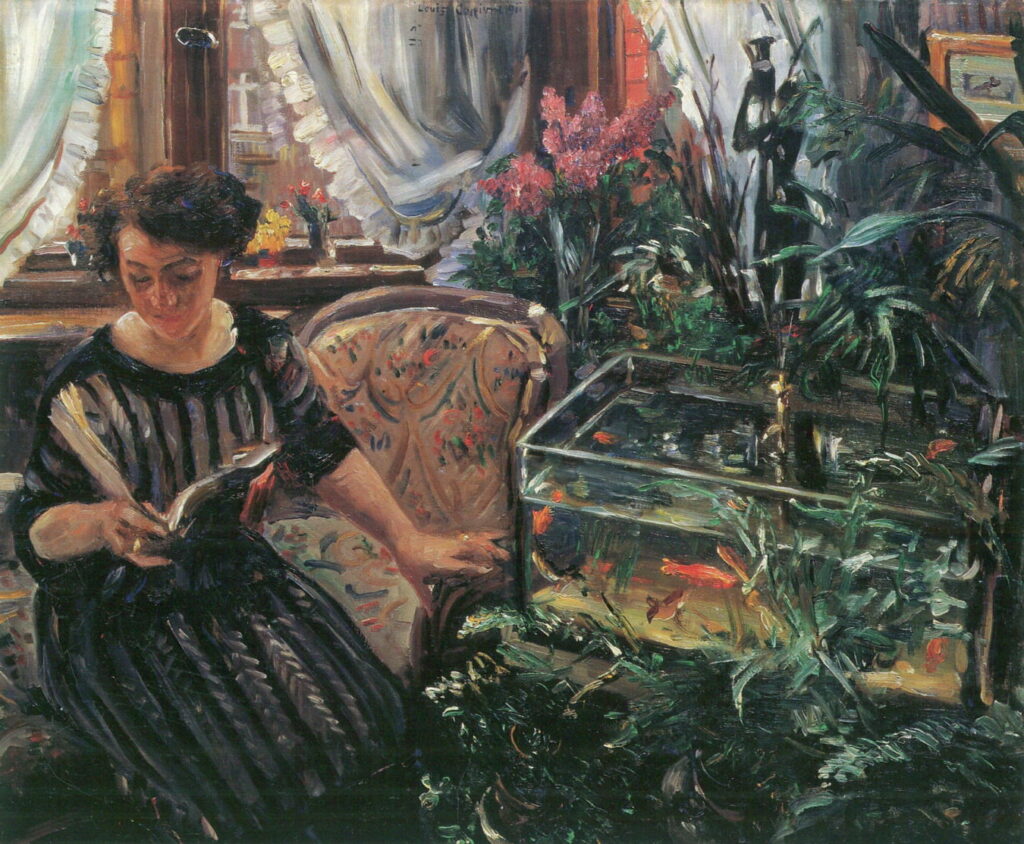Lovis Corinth and Charlotte Berend: 1 Painting days of wine and roses

On 26 March 1903, a pretty twenty-two year-old art student married her teacher, who was twice her age. She was already carrying their first child Thomas, who was born the following October. She was Charlotte Berend, the first student in Lovis Corinth’s new private painting school for women, in Berlin. What neither of them realised at that time was that in less than ten years, it would be Charlotte teaching her husband to paint.
Lovis Corinth had been born as Franz Heinrich Louis Corinth in the village of Tapiau, in what was then the northern part of East Prussia. He started learning to paint at the local academy in the nearby city of Königsberg (now Kaliningrad). He completed his training in Munich, from where he visited Antwerp and Paris, there enrolling in the Académie Julian and studying under Bouguereau and Robert-Fleury. After struggling to obtain recognition at the Salon in Paris, he settled in Munich, the arts capital of Germany in 1891.
Lovis Corinth (1858–1925), View from the Studio, Schwabing (1891), oil on cardboard, 64.5 × 50 cm, Private collection. Wikipedia Commons.
Corinth set up his studio in Munich’s most bohemian and artistic district, and painted this quick sketch of the View from the Studio, Schwabing in 1891. He realised that his progressive style of painting was at variance with both the Munich Academy and the critics, and the following year took part in the foundation of the Munich Secession to try to change that. Much of his painting during his nine years in Munich was experimental, although critics have accused him of spending more time drinking large amounts of red wine and champagne.
Lovis Corinth (1858–1925), Self-portrait with Skeleton (1896), oil on canvas, 66 × 86 cm , Städtische Galerie im Lenbachhaus, Munich. Wikipedia Commons.
He painted this Self-portrait with Skeleton in his Munich studio in 1896, his face showing the effects of that high living.
Lovis Corinth (1858–1925), The Deposition (1895), oil on canvas, 95 × 102 cm, Wallraf-Richartz-Museum, Cologne. Wikipedia Commons.
The Deposition (Descent from the Cross) from 1895 won him a gold medal when it was exhibited in the Glaspalast in Munich that year. It shows the traditional station of the cross commemorating the lowering of the dead body of Christ from the cross, attended by Joseph of Arimathea and Mary Magdalene.
In 1897 he started to make increasingly frequent visits to Berlin, where he was able to obtain lucrative commissions for portraits. When the Berlin Secession was founded in 1898, Corinth was among its members. By 1900, he was renting a studio in Berlin, and closed his studio in Munich and moved to Berlin in the autumn of the following year.
In his last few years in Munich, Corinth worked on a series of two paintings exploring the story of Salome and John the Baptist’s execution. He seems to have started this work with a drawing in 1897, eventually leading to one of his greatest paintings.
Lovis Corinth (1858–1925), Salome (II) (1900), oil on canvas, 127 × 147 cm, Museum der Bildenden Künste Leipzig, Leipzig. Wikimedia Commons.
Corinth’s second Salome from 1900 was his first masterpiece. Salome has a neutral facial expression, and is staring intently at the lower abdomen of the executioner. Her right hand is stretching open the left eye of John the Baptist’s head, which appears to be staring up at her. The executioner and the young woman at the top right are laughing at one another, but the third woman beside her has a serious, almost sad expression, as she stands holding a large peacock fan. Visible at the top of her clothing, directly below her chin, is the small image of a human skull.
His timing was perfect. Oscar Wilde’s one-act play Salome had been first published in French in 1891, and was soon translated into English and German. Banned from public performance in Britain, it received its premier in Paris in 1896, but wasn’t performed in public in England until 1931. Wilde had been influenced by Gustave Moreau’s paintings of Salome, and in turn influenced both Corinth’s paintings and Richard Strauss’s later opera in 1905. This painting was rejected by the Munich Secession, but welcomed by the Berlin Secession, resulting in him being dubbed ‘the painter of flesh’. His reputation was established, and his future in Berlin secured.
In 1902, he opened a painting school for women, and among his first pupils was Charlotte Berend, then just twenty-one and the daughter of a rich textile merchant.
Lovis Corinth (1858–1925), Self portrait with Charlotte Berend-Corinth (1902), oil on canvas, 98.5 x 108.5 cm, Private collection. Wikimedia Commons.
Self portrait with Charlotte Berend-Corinth (1902) is the first portrait he painted of his fiancée and himself. This refers to Rembrandt’s Self-Portrait with Saskia (The Prodigal Son) (1636), below, where Saskia is sat on Rembrandt’s lap as he raises a large fluted glass of beer in his right hand. Charlotte, here in the role of Saskia, looks quiet and calm, against Corinth/Rembrandt’s alcohol-fuelled mirth.
Rembrandt Harmenszoon van Rijn (1606–1669), Rembrandt and Saskia in the Parable of the Prodigal Son (c 1635), oil on canvas, 161 x 131 cm, Gemäldegalerie Alte Meister, Dresden, Germany. Wikimedia Commons.
Lovis Corinth (1858–1925), Paddling (1902), oil on canvas, 83 x 60 cm, Niedersächsisches Landesmuseum Hannover, Hanover. Wikimedia Commons.
The following year the couple holidayed in the resort of Horst (now Niechorze) on the Baltic Coast, where Charlotte went Paddling (1902).
Charlotte Berend and Lovis Corinth married on 26 March 1903, when he was 44, and she was only 22. In the autumn their first child, Thomas, was born, and in 1909 their daughter Wilhelmina.
Lovis Corinth (1858–1925), Self-portrait with Model (1903), oil on canvas, 101 × 90 cm, Kunsthaus Zürich, Zürich, Switzerland. Wikimedia Commons.
Self-portrait with Model (1903) is the couple’s second joint portrait, and the first after their marriage. This time her pose refers to the classical images of muses by Rubens and Ingres, alluding to the story of Pygmalion.
In 1906, Corinth took his wife and young son to his home village of Tapiau, and the city of Königsberg where his training and career had started, and the following year they travelled to Florence, where he copied frescos using pastels.
Lovis Corinth (1858–1925), Bacchante Couple (1908), oil on canvas, 111.5 × 101.5 cm, Private collection. Wikimedia Commons.
Bacchante Couple (1908) is, of course, a self-portrait with Charlotte apparently enjoying their wild lifestyle at the time. This may also have been a birthday celebration.
Lovis Corinth (1858–1925), The Artist and his Family (1909), oil on canvas, 175 × 166 cm, Niedersächsisches Landesmuseum Hannover, Hanover, Germany. Wikimedia Commons.
Another of his most popular paintings from this period is this group portrait of The Artist and his Family (1909). All dressed up for what may have been intended to be a more formal group portrait, Charlotte sits calmly cradling daughter Wilhelmine, then just five months old, as the artist is struggling to paint them. Their son Thomas, aged five years, stands on a desk so that he can rest his hand on mother’s shoulder.
Lovis Corinth (1858–1925), Woman with a Fishtank (the Artist’s Wife) (1911), oil on canvas, 74 × 90.5 cm, Österreichische Galerie Belvedere, Vienna, Austria. Wikimedia Commons.
Woman with a Fishtank (1911) shows Charlotte in their flat on Klopstockstraße in Berlin. The aquarium, full of goldfish, is surrounded by quite a jungle of indoor plants, Charlotte’s little corner of vegetation within the city flat. According to her later memoirs, Corinth took just four days to complete this painting.
Lovis Corinth (1858–1925), Large Still Life with Figure (Birthday Picture) (1911), oil on canvas, 150.5 × 200 cm, Wallraf-Richartz-Museum & Fondation Corboud, Cologne, Germany. Wikimedia Commons.
Corinth’s celebration of his fifty-third birthday on 21st July was inevitably more muted than in his younger days, but he seems to have enjoyed painting a Large Still Life with Figure (1911), featuring Charlotte in a surprising outfit. They must have enjoyed quite a banquet afterwards, judging by the dead game on the table.
In December 1911, just five months after that party, Corinth suffered a stroke: the whole of his left side, both arm and leg, was paralysed. Corinth had painted his entire professional career with his left hand. He was only 53.




